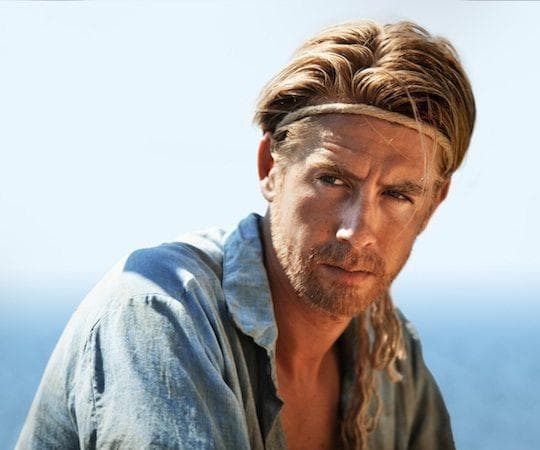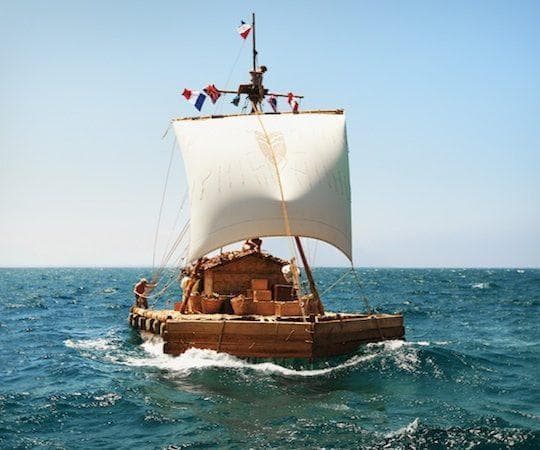Advertisement
'Kon-Tiki' Three Ways: Big Screen, Small Screen Or Hand-Held?
When Thor Heyerdahl set sail in the Pacific on a hand-made raft in 1947, bets were made on when, not if , he’d sink and perish.
A budding ethnographer, Heyerdahl was dead-set on proving that South American natives could have settled the Polynesian Islands, though prevailing science credited Asian populations. He convinced an amateur crew to float the Kon-Tiki, named for an Incan sun god and built in traditional methods dating back 1500 years, through the deep black Humboldt Current that connects Peru to Polynesia.
This unprecedented voyage made global headlines and secured near mythic status for the five Norwegian explorers (and one Swede), especially back home. Heyerdahl’s 1950 “Kon-Tiki” book sold more than 50 million copies and a documentary, with much of the footage shot on the raft by Heyerdahl himself, won an Academy Award in 1951.
The journey is back in circulation, this time as a fictional film. To secure funding, directors Joachim Ronning and Espen Sandberg shot “Kon-Tiki” the movie twice—scene by scene, first in Norwegian then in English — with the same strikingly blue-eyed actors (Pål Sverre Hagen plays Thor), blocking, camera angles, and shark special effects. The Norwegian version was nominated for best foreign language film in last year’s Academy Awards. The English version opens today at Kendall Square Cinema.

Though it takes place on the open sea, clearly, it’s a story with legs. The question is, which form would best resonate with you?
“Kon-Tiki: Across the Pacific by Raft” was the first “adult” book I read. At the time I perceived it as a type of punishment. My teacher decided a few of us needed extra work; we were to zip through our title and pass it on as part of a reading race. Even with the black and white snapshots of shark fishing by hand, it was an excruciating, endless passage of men, waves, and sea creatures that lasted all of fourth grade. I did not win, nor did I grasp the magnitude of Heyerdahl’s accomplishment, or why it mattered in 1985. But his tenacity stuck with me.
Cut to the fictional film’s release decades later. That it was directed by and starred mostly Norwegians seemed a plus, as I’ve been aware of how much Heyerdahl is revered in Norway. (Oslo is home to the Kon-Tiki Museum and documents Heyerdahl’s many subsequent raft expeditions.) And so with some anticipation I set out to re-examine my own fading but not entirely vanished maiden voyage.
“Kon-Tiki” is every bit an entertaining movie. By that I mean it glistens and floats on top of the 15-foot swells as one would expect from an oceanic epic. Teeth are whiter than white. Hair blonder than blond. Storms and an exaggerated musical score surge and break. While not a big deal in the 50s, washboard abs make frequent appearances. And so do life-like, ominous whale sharks and glow in the dark fish. It’s a romping adventure, much like “Life of Pi” only with a happier outcome.

There are a few dramatic set-ups before the Kon-Tiki pushes off that become predictable dramas to heighten the tension at sea. The movie opens with an incident from Heyerdahl’s childhood that at once suggests his daring and his fear of water. Of course this fact is used as ammunition to question Heyerdahl’s leadership later on. There’s also a “wife who doesn’t want him to go” thread.
One character suffers unnecessarily in service to a subplot. Herman Watzinger is introduced as a pudgy refrigerator salesman who tags along with the crew as an antidote to his ennui. Out of fear, he begs Heyerdahl to reinforce the balsa logs with modern gear. In the book Heyerdahl practically gives Watzinger a co-captain credit. He’s an astute engineer with significant technical responsibilities, including overseeing the construction of the raft. (Watzinger’s family expressed their frustration with his character’s depiction to the Norwegian media last year.)
For it’s part, the documentary is a worthy specimen, especially if that’s your preferred media. It was assembled from 16mm footage recovered after the raft ran aground on the reef of Raroia Island. From it we learn how the crew collected flying fish off the deck every morning for breakfast, how they were the first humans to see several different species, how floating along on nature’s course without the sound or exhaust of a motor made certain discoveries possible.
Erin Trahan edits The Independent, an online magazine about independent filmmaking and exhibition.
This program aired on May 3, 2013. The audio for this program is not available.

